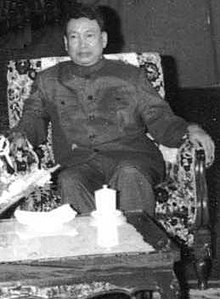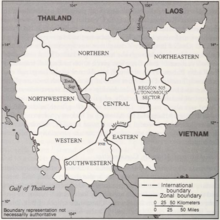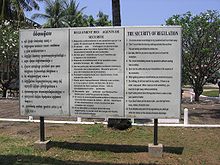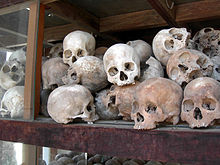Khmer Rouge
![]()
The articles Communist Party of Kampuchea and Khmer Rouge overlap thematically. Information that you are looking for here can also be found in the other article. You are welcome to participate in the relevant redundancy discussion or to help directly to merge the articles or to better distinguish them from one another (→ instructions).
The Khmer Rouge (Khmer ខ្មែរក្រហម Khmêr-krâhâm; French Khmers rouges) were a Maoist nationalist guerrilla movement that came to power in Cambodia in 1975 under the leadership of Pol Pot and ruled the country as a totalitarian state party until 1979. Its name derives from Cambodia's majority ethnic group, the Khmer. The Khmer Rouge sought to forcefully transform society into agrarian communism. This process included the almost complete expulsion of the population of the capital, Phnom Penh, and resulted in the Cambodian genocide that gained worldwide notoriety. By the end of their rule in 1979, some 1.7 to 2.2 million Cambodians (Khmer and members of ethnic and religious minorities) had fallen victim to the Khmer Rouge, according to the most widespread estimates.
After their violent overthrow and the crushing of their regime by Vietnamese invasion troops, the Khmer Rouge once again became an underground movement and were supported by various countries, including Western countries, in their fight against the Vietnamese occupying power and the puppet regime it had installed, until they finally disbanded in 1998. A legal reappraisal had not taken place until then. It was not until the 1990s that the UN began to press for a legal reappraisal and set up the Khmer Rouge Tribunal. Due to a conflict of interest between the UN and the Cambodian government, the first trial did not formally take place until 2007.

Pol Pot, leader of the Khmer Rouge
Origins
The proportion of the rural population without land ownership had risen from 4 to 20 % in Cambodia in the years 1950-1970 and increased further in the course of the Cambodian Civil War. It was primarily from this group, and in particular the youth with no ties to village community or land ownership, that the Khmer Rouge recruited. On the other hand, due to border shifts under the colonial rule of French Indochina, significant minorities such as Vietnamese and Muslim Cham had emerged in Cambodia, which had been relatively homogeneous ethnically until then. These minorities were poorly integrated and were particularly persecuted for nationalist reasons during the later genocide.
The Khmer Rouge had its origins in the Communist Party of Cambodia, which emerged from the Indochinese CP in 1951 and was initially called the Khmer People's Revolutionary Party (RVPK) and later the Workers' Party of Kampuchea (WPK). By 1954, Sơn Ngọc Minh and Tou Samouth had gained over 1,000 party members and, under ViệtMinh's supervision, the Khmer Issarak militia was expanded to over 5,000 men. The left wing of this militia, whose members Norodom Sihanouk disparagingly referred to as Khmer Viet Minh, included later Khmer Rouge leadership cadres such as Ta Mok and Keo Meas. Prince Sihanouk, who became the sole ruler after a rigged election victory in 1955, suppressed political opposition, causing a third of RVPK members and many "Khmer Viet Minh" to flee to Hanoi. In addition, Cambodia had achieved independence with the Indochina Conference, which meant that many militants considered their goals achieved and the Khmer Issarak all but disbanded. While the older, Vietnam-oriented party cadres, most of whom were close to the people, were particularly severely persecuted by the secret police, the younger generation, who came from better backgrounds and often had an academic education, remained exempt from repression. A circle of former students from Paris around Pol Pot therefore gained influence in the RVPK at this time and took over the party leadership after the assassination of Samouth, which was probably due to them, in early 1963. This soon went underground, so that from 1967 onwards a communist guerrilla movement arose against the regime of Sihanouk in the countryside.
In September 1966, the WPK renamed itself the Communist Party of Kampuchea (CPK), possibly intended by Pol Pot to signal a distancing from Hanoi and a rapprochement with the Chinese Communist Party. On January 17, 1968, a skirmish with government forces occurred during the Samlaut Uprising, which was later hailed by the Khmer Rouge as the birth of their military wing. At the time of its official formation in March 1969, the armed wing numbered just under 800 guerrillas and grew to 40,000 by 1972.
Until 1970, Sihanouk had kept Cambodia out of the crises that shook the region (the Vietnam War and its expansion into Laos) through skillful diplomacy, and the country was considered one of the more politically stable in Southeast Asia. It was a thorn in the side of the United States that the Vietnamese FNL (Viet Cong), fighting against American troops in Vietnam, used the eastern part of Cambodian territory as a transportation route (including the Ho Chi Minh Trail) and retreat area. The FNL supported the communist guerrilla movement in Cambodia. The group had renamed itself several times, which is why King Sihanouk used the collective term "Khmer Rouge" to the press for all groups in the leftist camp, which then became accepted abroad; the Khmer Rouge themselves had never called themselves that. Still under Sihanouk's rule, the proxy war in eastern Cambodia escalated, especially with the start of Operation MENU. In the border area to Vietnam, the Vietcong, the North Vietnamese Army (NVA), the Khmer Rouge, the armed forces of Cambodia and the United States Air Force were fighting each other.
After his overthrow by Lon Nol on March 18, 1970, Sihanouk went into exile in Beijing and allied with the Communist resistance in the Front uni national du Kampuchéa (FUNK). As the Gouvernement royal d'union nationale du Kampuchéa (GRUNK), Sihanoukists and the CPK formed a government-in-exile that included Khieu Samphan, Hu Nim, and Hou Yuon. As a national identification figure, Sihanouk was able to mobilize the rural population in particular for his purposes to a considerable extent. Thus, only two days after his fall, he called on Cambodians to go to the forests and join the resistance, which many ordinary Khmer Rouge soldiers later described as the triggering moment of their recruitment. Such was the reverence for Sihanouk that even many monks rallied to the GRUNK cause. The revolutionary morale of these fighters left much to be desired, however, and communist ideas such as revolt against large landowners, which hardly existed in Cambodia, proved to be rather an obstacle to further recruitment. Until 1972, it was mainly the NVA and "Khmer Viet Minh" returning from Vietnamese exile who led the Cambodian Civil War against Lon Nol, taking most of the northeastern provinces.
While the leadership around Pol Pot, also known as Brother No. 1, was oriented towards Beijing and hostile towards Vietnam, many local party cadres and the Khmer Issarak, especially in eastern Cambodia, still cooperated with the Viet Cong. The Khmer Rouge power center around Pol Pot and Nuon Chea, also known as Brother No. 2, began politically cleansing the movement of Sihanoukists, Khmer Issarak, and moderate, pro-Vietnamese communists beginning in 1971. In most regions of the country, this operation was completed by 1975. The assassination campaign also targeted ethnic minorities within the party and militias, such as Thai nationals in Koh Kong province and hill tribesmen in Ratanakiri province. The United States State Department, which conducted one of the first studies of the Khmer Rouge in 1973/1974 based on interviews with refugees, was able to identify this rift within the movement between the hardliners of the Khmer Krahom (German: "Rote Khmer") and the moderate forces of the Khmer Rumdos (German: "Khmer Liberation"). An original Khmer Rouge faction, which by the end of 1974 had entered into armed conflict with the CPK, was the Khmer Saor (German: "White Khmer"), which consisted of Muslim Cham. These were tolerated as an autonomous militia within the ranks of the Khmer Rouge only in the eastern administrative zone, but were dissolved by the central party leadership in 1974.
Army General Lon Nol, whose coup had been supported by America, received extensive economic and military aid from Washington. With his approval, Richard Nixon and his Secretary of State Henry Kissinger attempted to militarily purge Cambodia of the FNL. By extending the war against communist North Vietnam and the Viet Cong onto Cambodian soil, the U.S. sacrificed the integrity of Indochina's last independent state. Its area bombing campaign, beginning with Operation MENU, claimed at least 200,000 lives, mostly among civilians, and helped drive a large segment of the population into the arms of the Khmer Rouge. A total of 2,756,941 tons of bombs were dropped by American B-52 aircraft on Cambodia from October 4, 1965 to August 15, 1973, and twice as many bombs were dropped on Japan in 1973 alone as were dropped on Japan during all of World War II (2 million tons of bombs were dropped in all of World War II - including Hiroshima (15,000 tons) and Nagasaki (20,000 tons)). Cambodia is half the size of Germany. That the Vietnamese and Americans took their war to Cambodia explains to some extent the nationalistic and hateful course of the Khmer Rouge.

Administrative Zones Democratic Kampuchea (Source: Russell R. Ross (ed.): Cambodia. A Country Study. Federal Research Division 1990)
Khmer Rouge rule
On April 17, 1975, Phnom Penh was captured by the Khmer Rouge, "Democratic Kampuchea" was proclaimed, and Prince Norodom Sihanouk, who was living in exile, was installed as head of state.
Most of the town's inhabitants rejoiced at the end of the fighting and greeted the invading troops with jubilation. A large part of the fighters consisted of child soldiers, who at that time knew nothing else than a life as soldiers.
The mood quickly changed when Pol Pot and the Khmer Rouge began to establish a regime of terror. On April 4, 1976, Norodom Sihanouk was deposed as head of state and placed under house arrest for his criticism of the Khmer Rouge's course, Khieu Samphan was appointed the new head of state, and Pol Pot was named head of government.
Secrecy
One peculiarity of rule in Cambodia that distinguished it from the other dictatorships was the complete secrecy of the party and leading officials. They hid behind an ostensible organization called angka (short for angka padevat, "revolutionary organization"). Pol Pot made his first public appearance only about a year after taking power in March 1976, as a "rubber plantation worker". Pol Pot had no biography of himself published, there were no collections of texts and only a few photos of him. Many Cambodians only learned of the identity of their head of government after his fall.
Ideology and reality
Pol Pot adhered to communist ideas as a young man and joined the Communist Party of Cambodia at the age of 18 and the French Communist Party a little later, when he was a student in Paris. He saw the causes of Cambodia's poverty, apart from the corruption of the Lon Nol regime, precisely in the difference between town and country. So he believed he had to strengthen the peasantry and destroy everything urban.
Although the Khmer Rouge were oriented towards Maoism, they showed clear differences in ideological orientation to the People's Republic of China. Central elements of communism, such as industrial progress, mechanization, and the proletariat as the bearer of revolution, were absent, whereas the peasantry was glorified and the leadership acted in extreme secrecy, even when it held state power. Because of these characteristics, the rule of the Khmer Rouge was also referred to by the political catchword Stone Age Communism.
The immediate deportation of the urban population to the rice fields of the country turned Phnom Penh, which had previously had over two million inhabitants, into a ghost town within a few days, and the provincial capitals were also depopulated. During this "long march", which lasted up to a month, thousands of people (especially the elderly and children) died due to the hardships.
Soon every survivor was transformed into a worker and forced to wear a black uniform that would eliminate all individuality. Khmer Rouge spokesmen proclaimed the beginning of a new revolutionary age in which every form of oppression and tyranny would be abolished.
In the first months of this revolutionary era, the country was transformed into a gigantic labor and prison camp. Daily working hours of twelve hours or more were not uncommon, and the workers' every move was so monitored that almost everyone had to fear for their lives. Anyone late for work could be executed on suspicion of sabotage. Talking while working was forbidden.
Money was abolished, books were burned, teachers, merchants and almost the entire intellectual elite of the country were murdered in order to implement the agrarian communism that Pol Pot had in mind. The intended shift of economic activity to the countryside brought it to a complete standstill, as industrial and service enterprises - banks, hospitals, schools - were also closed.
Furthermore, the Khmer Rouge banned all religious practice. In the course of its efforts to eradicate religion, the Pol Pot regime had hundreds of Buddhist monasteries, Christian churches and mosques destroyed.
In 1976, Pol Pot drew up a four-year plan that was supposed to eliminate all class differences and lead the country into a "prosperous communist future. Cambodia's agricultural productivity was to be tripled in order to obtain the necessary foreign currency through food exports. But this goal was not achieved, as the economic infrastructure was largely destroyed and agricultural workers were largely left without tools.
Food supplies also collapsed due to misplanning and mismanagement. Fearing reprisals, local leaders falsified crop reports. The yield was nevertheless taken away. Food shortages and forced labor, as well as lack of medical care, led to the deaths of hundreds of thousands. Many of the responsible leaders were imprisoned for sabotaging the Four-Year Plan and perished.
Mass murder
At the same time, so-called mass purges were carried out. Those suspected of collaborating with foreigners were murdered along with their spouses and children. It was not only Pol Pot and the Khmer Rouge who blamed minorities, especially Vietnamese and foreigners, for Cambodia's plight. The Vietnamese were not only unpopular because they had brought the war to Cambodia, but also because they - brought into the country by the French for administrative duties during the period of French colonial rule in Indochina - were for many a symbol of foreign domination of the country. In addition, the Khmer Rouge claimed the Mekong Delta (Kampuchea Krom) for Cambodia, which had fallen to Vietnam as Cochinchina under French colonial rule.
The "bourgeoisie" was "abolished", and to be a "bourgeois" it was often enough to be able to read or speak a foreign language (especially French). Under the Khmer Rouge dictatorship, opposition figures such as monarchists and supporters of the Lon Nol regime and their spouses and children were killed en masse, as were those communists who had returned to Cambodia from Vietnam shortly before the takeover.
During the four-year reign of terror, an estimated 1.7 to 2.2 million people were killed in death camps or perished in forced labor in the rice fields (out of a total population of just over seven million, representing one-quarter to over 30%). In the notorious "Security Prison 21" in Phnom Penh, run by Kaing Guek Eav, known by his pseudonym "Duch" (also "Dëuch" or "Deuch"), seven prisoners survived out of a total of 15,000 to 30,000. Those who did not die of torture there were killed on the Killing Fields outside the city gates.
The mass cleansing is also referred to as autogenocide, as the government's extermination measures targeted its own people. Also affected by mass killings were members of the Vietnamese minority, the indigenous Muslim Cham and the hill tribes. The rights of these and other ethnic groups were fundamentally disregarded by the Pol Pot regime. A Democratic Kampuchea government document published in 1977 stated that minorities accounted for only 1% of the population, when in fact they accounted for 20%. Thus, the hill tribes were referred to as "Khmer Loeu" (German: "upper Khmer") and the Cham as "Islamic Khmer." While David P. Chandler and Michael Vickery, in their works on the recent history of Cambodia, classified the Pol Pot regime as chauvinistic but did not speak of genocide in this context, Ben Kiernan was the first historian to explicitly refer to the Khmer Rouge's minority policies as ethnic cleansing. In addition to the Cham and Vietnamese, the Chinese minority was also a victim of the Khmer Rouge, decimating the number of ethnic Chinese from 430,000 to 215,000. In this case, the cause of the genocide is not so much the racism of the KPK leadership as the social structure of the Chinese population group: Since the Chinese lived predominantly in the cities and were often wealthier and more educated than the average population, they were especially likely to be deported to the countryside as New People. Since, unlike many Khmer among the New People who came from villages or had relatives there, they were unaccustomed to hard field work and the privations, they were particularly likely to die of debilitation or disease. Many Chinese were also identified as middle-class intellectuals and murdered. The mass murders of the Vietnamese and Cham were explicitly described as genocide in the later criminal trial of members of the Khmer Rouge.
Reports of Khmer Rouge atrocities continued to generate debate until their removal. The reports by John Barron and Anthony Paul, as well as Father François Ponchaud, who was the first to write about mass killings in Cambodia in his 1977 book Cambodge - année zéro, were portrayed by Western leftists such as media critic Noam Chomsky as not objective. The attention given in the press to the reported human rights violations from Cambodia was disproportionate to the atrocities committed by the Americans in Cambodia and Vietnam, Chomsky and Edward S. Herman wrote in The Nation on June 6, 1977. Chomsky rejected the accusations that his criticism at the time amounted to a relativization of the Khmer Rouge's reign of terror. Rather, he said, his criticism should be seen as a refutation of the portrayal of Cambodia as a "meek country" that was suddenly thrust into the abyss by the Khmer Rouge in 1975.
Casualty figures
To date, several mass graves with a total of approximately 1.39 million bodies have been discovered, excavated and evaluated in the country. Various studies differ in their estimation of the total number of victims between 740,000 and 3,000,000. Most range between 1.4 million and 2.2 million, whereby half of the causes of death are assumed to be executions (such as by shooting, beating to death, decapitation with field hoes and suffocation with plastic bags; small children were crushed on trees) and the other half death through lack of food and disease.

Plaque at the Tuol Sleng memorial site with the rules that were binding for the prisoners of the camp

Skulls of victims of the Khmer Rouge

Khmer Rouge clothing
Search within the encyclopedia